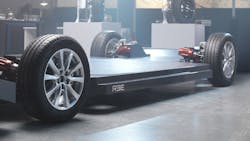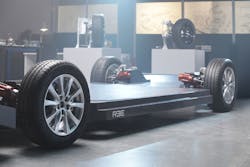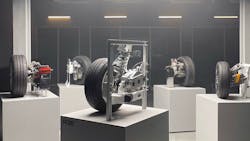“REEcorners” Bring Fully Flat Platforms to Commercial EVs
What you'll learn:
- What is a REEcorner?
- Creation of a fully flat EV platform
- How does the REEboard's modularity and flexibility impact design?
EV engineers haven’t yet succeeded in efficiently putting all that’s needed for motive force inside each wheel, creating so-called hub motors. However, a promising approach that appears to be close comes from the Israeli company REE. Its “REEcorner” packs critical vehicle components into a single compact module positioned between the chassis and the wheel—including steering, braking, suspension, powertrain, and control—resulting in a fully flat EV platform.
To fulfill specific customer needs, REE unveiled five new “REEcorner” architecture designs to support commercial electric vehicles:
- EV platform size based on preferred length, width, and vehicle height
- Front, rear, or all-wheel drive
- Peak motor power ranges of 35 to 200 kW
- Front and all-wheel steering
- Different suspensions
Unlike diesel/fuel vehicles or conventional EVs, REE's fully flat EV platforms are designed with a lower center of gravity than vehicles with the motor located in between the wheels, and they’re intended to carry more passengers, cargo, and batteries. REE's smaller footprint and lower center of gravity will also allow for taller cabin designs and lower step-in height, yielding more volumetric efficiency.
Ahishay Sardes, REE co-founder and CTO, explains REE's differentiation: "Unlike in-wheel motor systems, the motors in REEcorners are fully sprung masses, positioned on the chassis side of the suspension. By minimizing unsprung mass, REEcorners are designed for optimal ride and handling vehicle dynamics.”
Utilizing x-by-wire technology to control each of the vehicle’s corners with full drive-by-wire, brake-by-wire, and steer-by-wire technology, REE's design further includes the REEcenter ECU (electrical control unit) system to coordinate all four independent REEcorner ECUs, as well as a thermal-management system, power converters, and power modules.
REE’s EV platforms are designed to improve driver ergonomics, enabling the creation of commercial delivery vans with a low center of gravity, 360-deg. all-side accessibility, and unrestricted visibility for easy loading. What’s more, REE expects that electric vehicles built on its EV platform will offer up to 35% more interior space than comparable commercial vehicles of similar size. This provides more room for cargo and goods and thus leads to fewer delivery routes for reduced carbon impact. REE's smaller footprint also saves space in warehouses and parking areas, while allowing for easier maneuverability in crowded zones.
By adopting REE's platforms, Mobility-as-a-Service providers can be empowered to build front-wheel drive e-shuttles with maximum payload capacity for transporting passengers with minimal kilowatt-per-hour consumption. Conversely, logistics companies will be able to choose low-speed, all-wheel-drive, all-wheel-steering REEcorner configurations for last-mile delivery. Low step-in-height and minimum turning radius facilitates maneuverability in congested urban streets.
The technology makes it possible for commercial delivery vans to be equipped with 360-deg. all-side accessibility and unrestricted visibility for easier loading/unloading in docking stations.
REEcorner Benefits
Each REEcorner is completely independent and powered by its own ECU, controlling all corner-level functions, including:
- A fully sprung high-RPM electric motor
- Single-wheel steer-by-wire technology
- Single-wheel brake-by-wire technology
- High-efficiency drivetrain
- Preventive-maintenance AI
- OTA updates
The technology allows for extreme modularity in a way that each corner can be tailored to any vehicle requirements.
REE also developed another core innovation: the REEboard. It’s a completely flat and modular electric platform enabling multiple body configurations and bringing about greater design freedom and space efficiency. Since the REEboard doesn’t store any drive components, it can be designed to take any shape in a mission-specific vehicle. Powered by REEcorner technology, the REEboard provides more volume on a smaller footprint with more capacity for batteries or fuel cells within the chassis.
The REEcorner drives maintenance costs down by constantly monitoring potential failures through proprietary preventative-maintenance AI. When a needed revision is identified, an OTA update can be sent, or if required, an entire REEcorner can be replaced with a new one.


